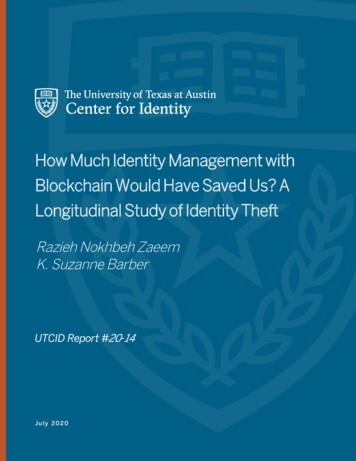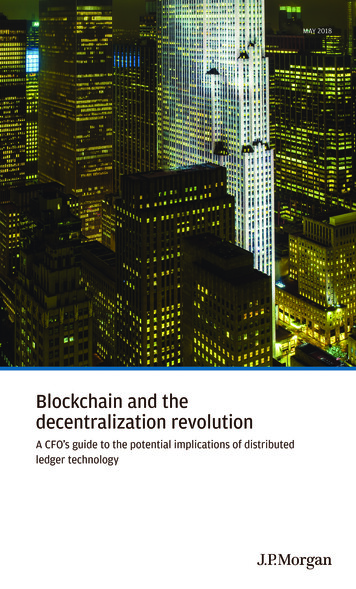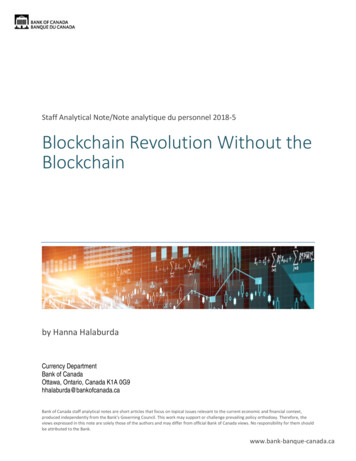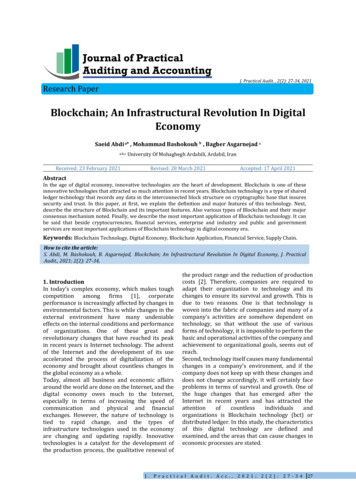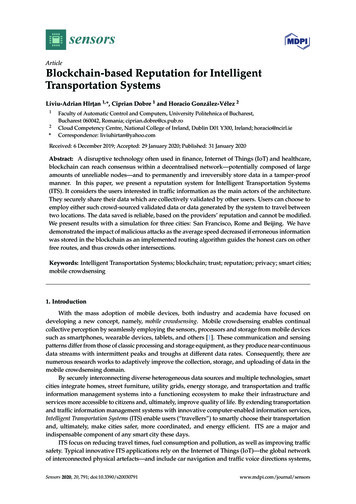
Transcription
sensorsArticleBlockchain-based Reputation for IntelligentTransportation SystemsLiviu-Adrian Hîrţan 1, *, Ciprian Dobre 1 and Horacio González-Vélez 212*Faculty of Automatic Control and Computers, University Politehnica of Bucharest,Bucharest 060042, Romania; ciprian.dobre@cs.pub.roCloud Competency Centre, National College of Ireland, Dublin D01 Y300, Ireland; horacio@ncirl.ieCorrespondence: liviuhirtan@yahoo.comReceived: 6 December 2019; Accepted: 29 January 2020; Published: 31 January 2020Abstract: A disruptive technology often used in finance, Internet of Things (IoT) and healthcare,blockchain can reach consensus within a decentralised network—potentially composed of largeamounts of unreliable nodes—and to permanently and irreversibly store data in a tamper-proofmanner. In this paper, we present a reputation system for Intelligent Transportation Systems(ITS). It considers the users interested in traffic information as the main actors of the architecture.They securely share their data which are collectively validated by other users. Users can choose toemploy either such crowd-sourced validated data or data generated by the system to travel betweentwo locations. The data saved is reliable, based on the providers’ reputation and cannot be modified.We present results with a simulation for three cities: San Francisco, Rome and Beijing. We havedemonstrated the impact of malicious attacks as the average speed decreased if erroneous informationwas stored in the blockchain as an implemented routing algorithm guides the honest cars on otherfree routes, and thus crowds other intersections.Keywords: Intelligent Transportation Systems; blockchain; trust; reputation; privacy; smart cities;mobile crowdsensing1. IntroductionWith the mass adoption of mobile devices, both industry and academia have focused ondeveloping a new concept, namely, mobile crowdsensing. Mobile crowdsensing enables continualcollective perception by seamlessly employing the sensors, processors and storage from mobile devicessuch as smartphones, wearable devices, tablets, and others [1]. These communication and sensingpatterns differ from those of classic processing and storage equipment, as they produce near-continuousdata streams with intermittent peaks and troughs at different data rates. Consequently, there arenumerous research works to adaptively improve the collection, storage, and uploading of data in themobile crowdsensing domain.By securely interconnecting diverse heterogeneous data sources and multiple technologies, smartcities integrate homes, street furniture, utility grids, energy storage, and transportation and trafficinformation management systems into a functioning ecosystem to make their infrastructure andservices more accessible to citizens and, ultimately, improve quality of life. By extending transportationand traffic information management systems with innovative computer-enabled information services,Intelligent Transportation Systems (ITS) enable users (“travellers”) to smartly choose their transportationand, ultimately, make cities safer, more coordinated, and energy efficient. ITS are a major andindispensable component of any smart city these days.ITS focus on reducing travel times, fuel consumption and pollution, as well as improving trafficsafety. Typical innovative ITS applications rely on the Internet of Things (IoT)—the global networkof interconnected physical artefacts—and include car navigation and traffic voice directions systems,Sensors 2020, 20, 791; doi:10.3390/s20030791www.mdpi.com/journal/sensors
Sensors 2020, 20, 7912 of 23municipal/regional traffic signal control systems, electronic message/notice boards and automaticnumber plate recognition among other. In terms of number of users, by far the most widely-usedapplications are car navigation systems.Nonetheless, ITS come with a series of constraints mostly related to privacy preservation of users.Privacy preservation represents a major concern, taking into account the large volumes of data andthe current data protection regulations, e.g., General Data Protection Regulation in Europe. The useridentity must be protected so, first of all, all systems should provide a series of available policieswhereby users can choose which data they share with the system. Also, the analysis of the data createdby the devices and manipulated by other untrusted entities should not reveal personal information orany pattern through which it can be identified.By using blockchain technologies to address IoT privacy and security [2], we propose tointegrate travellers and public transport as a transportation continuum, to develop a secure reputationsystem where users transmit traffic information and receive travel information which can reliedon. The reputation is based on traveller behaviour and their history regarding the type of dataprovided to the system. The system determines the traffic conditions within the areas from which thedata is transmitted and can redirect users to the fastest routes according to the preferred meansof transport. Both reputation and valid traffic data are permanently stored in a tamper-proofblockchain which cannot be modified by attackers. Data validity is established by travellers withinthe same cluster/geographical area via a consensus mechanism that takes into account the reputationof participants.Widely considered immutable time-stamped data structures, blockchains implement peer-to-peernetworks where participants can verify interactions concurrently using decentralised peer-to-peerconsensus protocols. As an emerging technology trend, different research [3,4] and industrial [5]perspectives have been assembled to document its potential disruptive impact [6].Blockchains have five unique characteristics:1.2.3.4.5.Peer-to-peer communication without a central authority.Transparent transaction processing with optionally-disclosed ownership.Decentralised transaction history verifiable by all participants.Immutability of records assuring chronological sequence and accessibility.Logic-based processing to trigger algorithms and events.The aforementioned characteristics have made blockchain particularly suitable to managecryptocurrencies: electronic cash systems administered via peer-to-peer consensus. Indeed, the mostwidely known for cryptocurrency, the Bitcoin [7], remains somehow the gold standard for financialblockchain applications. Nonetheless, although blockchains have been used extensively in financialentities, their decentralised immutability characteristics have made them particularly suitable forapplications in other domains as diverse as Law [8], Food Traceability [9], Open-source SoftwareManagement [10] and indeed IoT [11].Blockchains can be construed as distributed databases in which all member-approved transactionsare permanently stored, as a result of a consensus algorithm. The transactions are stored withinblocks, in chronological order. The number of blocks is potentially unlimited, and the impossibilityof modifying them is realised through the implemented algorithms. The hash stored within eachblock is proof of the fact that the blocks are ordered and unmodified. The consensus algorithm isthe process through which the distributed network reaches an agreement on the transactions andblocks validity. The design of consensus algorithms also takes into account the fact that in the networkthere are unreliable nodes, processes or services may become unavailable, or communication may beinterrupted. An agreement can be reached with more than 50% of nodes within the network.This paper is organised in the following sections. Section 2 introduces an overview of relatedworks. Section 3 describes the proposed system design, including a detailed account of the appliedtransactions. Section 4 assembles a privacy and security analysis, followed by Section 5, where we
Sensors 2020, 20, 7913 of 23present our experimental results. Finally, Section 6 enumerates some conclusions and future directionsfor our work.2. Related WorkThis section presents the current state-of-the-art regarding establishing a reputation in ITS as wellas proposals for the implementation of reputation systems using blockchain. We have also consideredproposals on the improvement of the medium access control protocol in the wireless access vehicularenvironment as well as new methods to ensure the security and confidentiality in the blockchain.Finally, works on blockchain technology in reputation systems for ITS are analysed.In [12], the authors model pairwise trust and system-wide reputation of crowd contributors usinga linear algebra approach. With the aim of fostering explainability and auditability, their systemstores the contributor models as smart contracts in a private Ethereum network, and then implementsa recommendation and explanation engine based on the stored contributor trust and reputationsmart contracts.In [13], a reputation system is proposed based on blockchain technology with the purposeof solving the current generation reputation systems. Each user creates a positive transaction ifhe/she has received the requested file signed with the sender’s private key, or a negative transaction.The positive transaction consists of the reputation score, the timestamp and the hash of the receivedfile. The miners verify the validity of the transaction by contacting each entity involved in the processand requesting a signed proof consisting of file hash and a random nonce sent by the miner to beincluded. The miners assemble the verified transactions in a block. Among the methods to prevent thecreation of multiple identities, the authors propose to link the users with the IP address or with theemail address. Reputation is not stored in the blockchain; the clients calculate the reputation of othernodes by themselves.In [14], the authors propose a solution to certify the reputation of a member of the web communityon top of the Bitcoin blockchain. After purchasing a particular service or product, the vendor creates avoucher transaction with a voting fee and an incentive. This transaction is sent to the customer to beco-signed. The consumer has the possibility to sign the voucher, which implies the validation of thecontract execution. Thus, the producer’s reputation grows. A disadvantage of this system is the Sybilattack. An attacker can create fake consumer identities that will sign voucher transactions. As thevoting fee is a percentage of the price, free services or products are affected.A publisher–subscriber reputation system based on Bitcoin is presented in [15]. The model iscomprised of publishers, sensors, and subscribers. Publishers collect data using sensors and publisha topic. The subscribers suggest their intention to subscribe using the ElGamal encryption schemeand make a deposit. The publishers establish a correspondence between the requests and the topic,encrypt the data with a symmetrical key, and send the encrypted text to the subscriber. In addition,their role is to send this match to the Bitcoin system. The subscriber receives the notification and paysthe publisher. In the end, the publisher reputation is up to date and can receive bitcoins.2.1. Trust and Reputation in Vehicular SystemsTrust and reputation management in vehicular ad hoc networks (VANETs) is a crucial matter,as broadcasted messages that represent traffic events should be endorsed by drivers within thesame area and rebroadcasted or are discarded if the trust value is less than a predefined threshold.The overarching goal of trust in VANETs is to detect dishonest peers and their malicious data and,eventually, award incentives to honest peers discourageing self-interested behaviour [16]. A userreputation takes into account all endorsees made by other users, as well as a historical factor.Even though a vehicle may have a pseudonym as an identifier, systems should not provide amechanism for changing it and, thus, following certain patterns, the identity should not be revealed.In [17], a system for certified reputation is described, where vehicles communicate using digitalcertificates that contain the reputation level. The design includes additional entities, such as static
Sensors 2020, 20, 7914 of 23communications infrastructure units called Road Side Units, Governmental Transportation Authority,Certification Authority and Central Control of Traffic Operation. Central Control of Traffic Operationis responsible to check the events’ validity, taking into account the information provided by othervehicles, and to compute the vehicles’ reputation. The vehicles are able to communicate directly andcheck the reputation that is stored and transported using a hardware security module.In [18], the authors present the main wireless access vehicular environments, namely, IEEE 801.11pand IEEE 1609.4, as well as some proposals regarding the improvement of IEEE 1609.4 multichanneloperation. The aforementioned research studies improve some performance parameters, but alsohave some limitations. The VANET environment has as main components onboard units (OBUs),electronic equipment installed in vehicles, and roadside units (RSUs), electronic equipment installedon the roadsides having the role of communicating with OBUs. With the aid of these devices,vehicle-to-vehicle (V2V) and vehicle-to-infrastructure (V2I) communication are achieved. The authorsanalyse each of the works, also presenting improvement solutions without causing the performanceto decrease.An innovative method of protecting data privacy and avoiding collision attacks using blockchainis presented in [19]. The blockchain network acts as a proxy server or as a trusted authority. Its role isto register participants and generate pairs of public and private keys, to verify access to the data storedin the cloud in accordance with the encryption key and related security policy, as well as to re-encryptinformation if secondary users want to access the data. Also, the blockchain network has the role ofgenerating a contract to verify the use of data, data that is stored encrypted in a cloud server.In [20], the authors have presented a communication mechanism that provides trustworthinessfor vehicles behaviour based on a reward system. The blockchain is used to store details, such asreputation or public keys, about every vehicle within the system. Those have an encrypted uniquenumber issued by trusted entities such as vehicle sellers or authorised dealers. The reputation is earnedby calculation of some computation within the group communication, although it is not used in routecomputation. At the same time, the reputation of the vehicles does not diminish if they provide falseinformation. Given that vehicles communicate directly with other vehicles in the same geographicalarea, and their reputation is calculated by other traffic participants, we can conclude that an attackercan make a match between the real identity of a driver and his/her blockchain identity. The consensusprotocol is based on Proof of Driving, where the broadcasted message is validated if the verification ispassed by more than 50% of the cars within the same network. These authors have also presented in[21] a trust environment based on intelligent vehicle framework. The proposed mechanism uses threemain technologies: communication network, Vehicular Cloud Computing and blockchain technology.Blockchain architecture has seven layers; it also includes trust and privacy mechanisms.In [22], the authors present a reputation system based on blockchain technology where thecars rate the messages based on their own observations. The system is comprised of four types ofentities: trusted authority with the role of vehicle registration and capacity certification, ordinaryvehicle, malicious vehicle and miner. The vehicles have the ability to broadcast traffic data, verify thecredibility of messages received based on the issuer’s reputation and generate a rating. Miners areselected from vehicles and their role is to create a block with all the ratings and to send it to all thevehicles. Those check the block and if it is accepted, it is added to the blockchain. The blockchaincontains only validated ratings by other traffic participants. The presented system does not save trafficinformation, and privacy-preserving methods are not presented.In [23], a blockchain-based anonymous reputation system is presented. The following main actorsare part of the system; the Certificate Authority (CA), the Law Enforcement Authority (LEA) and thevehicles. The authors use a blockchain for certificates, a blockchain for revoked public keys and ablockchain for messages. The communication between vehicles is performed directly, in an encryptedmanner using a public–private key system. Although only the LEA knows the correspondence betweena public key and the real identity of a user, an attacker might figure out it by analysing the broadcastedmessages within the network and his/her physical presence in certain locations.
Sensors 2020, 20, 7915 of 23The authors of [24] describe a reputation-based blockchain mechanism to secure the cachein the vehicular environment and enhance the trust between cache stored and consumer vehicles.Each block contains, among others, the following fields; the name of the provider who served the data,the name of the data validator that updated the provider’s reputation and the name of the content.Through the peer-to-peer network, when a node requests information, data is forwarded between allintermediate nodes. Each of the intermediate nodes queries the blockchain asking about the provider’sreputation. Through this method, the authors ensure that the data is secure, but the disadvantage isthe generation of a large number of messages within the network. Finally, after consuming/validatingthe received data, the consumer node creates a new block informing the entire peer-to-peer networkabout its validation.A traffic event validation and trust verification mechanism are presented in [25]. The authorspropose the use of the Proof of Event mechanism in two-pass validation. Initially, the data is collectedby Roadside Units (RSUs) and broadcasted to vehicles within the same area. If those validate the datawithin a predefined period, RSU adds to the local-chain the traffic event, along with the signaturesof the vehicles that validated them. The system includes a local-chain maintained by RSUs withinthe same area and a global-chain updated over a longer period. Such a system is difficult to beimplemented because the installation and interconnection of RSUs over a large geographical area arequite expensive. Also, the system does not take into account the reputation of vehicles and their history.Thus, in a geographic area where a fake traffic event is guaranteed by three malicious vehicles andinvalidated by a vehicle with a good history, the event will be validated.2.2. ContributionDuring our research, we realised that establishing reputation and maintaining confidentiality atthe same time in blockchain-based ITS solutions is at an early stage. The various literature reviewedin these sections has some shortcomings. For example, there are proposals that establish trust in thesystem without taking into account privacy, other proposals do not use revealed trust in establishingfuture transactions and other proposals are difficult to be implemented in real-life. Our paper addressesthese shortcomings that can be found in the specialised literature, providing a system design thatguarantees trust in ITS while ensuring the confidentiality of the users’ identity. Table 1 shows acomparative analysis following the advantages and disadvantages of the proposed solutions using theblockchain technology in reputation systems implemented on ITS.Table 1. Comparative analysis of related work.Reference Work[21][20][22][23][24][25]OUR PROPOSALAdvantages and DisadvantagesUse Reputation MetricGuaranteed Confidentialityin Traffic Event ValidationnononononononoyesyesyesyesnoyesyesEasy Implementationin Real-Life Scenarioyesyesyesnononoyes3. System DesignIn this paper, we present the design of a reputation system based on blockchain technologyand applied in Intelligent Transportation Systems. Users have the possibility to receive real trafficinformation and, in turn, contribute with data to the system to have a common sense of traffic. Basedon their behaviour and, more precisely, the veracity of the information provided, the system takes intoaccount a very important variable, namely the users’ reputation. Depending on the users’ reputationsthat contributed with data, the design is able to make a final decision regarding the truth about it. Traffic
Sensors 2020, 20, 7916 of 23data cannot be affected by attackers using bots or fake emulated entities, and reputation or identitiescannot be modified or artificially inserted into the immutable ledger. Depending on the informationreceived, the software solution provides to customers useful and reliable traffic information, such asthe route from the start location to end location within a city. In the following, we will present thedesign of such a system, following the main components of blockchain technology.The system includes two main actors: the users and the central server. The entire system containsinformation such as traffic data, the reputation of enrolled users, and related maps. Customers aregrouped in clusters represented by geographic area, as shown in Figure 1, and, after the validationwithin the consensus algorithm, blockchain is used to store traffic events as well as the reputation ofthe users. The system uses the benefits of this technology such as immutability and security of storeddata in order to provide unaltered and reliable information to users. In the following, we present thetechnical details, taking into account the main components of blockchain technology.Figure 1. Geographical areas representing clusters.The proposed software solution involves the existence of two main actors: the users and thecentral server, represented by the corresponding software applications as shown in Figure 2.Users are represented within the system through the client application and are grouped accordingto their location, more exactly by latitude and longitude. The users have a set of security policiesat the client application level, and thus have the option of sharing data or not, to exclude locationsharing in some areas, to disable data sharing if the traffic speed is greater than a certain threshold,etc. They have the role to interrogate the server through the client application to get the optimal routefrom the starting location to the final location, using the best transport means. They also provideinformation regarding traffic, for example, traffic events or the availability of transport means. Also,they validate other events sent by users from the same cluster, during the consensus algorithm.The main storage and processing unit is represented within the system by the server application.It is designed to provide customers the optimal route from the start location to the end location.It receives traffic data sent by users through the client application, identifies other clients in thesame cluster/geographic area and interrogates them to validate the received traffic information.
Sensors 2020, 20, 7917 of 23The server also has the role to calculate customer reputation, to save it into internal blockchainalongside information regarding traffic.Figure 2. System design.As shown in Figure 2, each of the two systems, server application and client application aredivided into modules, each having a different and very important role in the whole.The server application has the following modules, as shown in Figure 3. Blockchain module: Stores blocks with user transactions, their reputation and traffic events.Traffic data is validated by users in the same cluster, whereas data regarding users and reputationsare created by the server.Network module: Manages the interaction with users through client applications toreceive/transmit route information, as well as to receive information about the availabilityof the means of transport. Also, this module has an important role in the consensus algorithm,as all members of the same cluster are interrogated regarding traffic events.Processing module: Enables the responses in real-time to user requests. It interacts withother modules within the server application and, through the network module, the processedinformation is transmitted to the clients. This module performs all processes, such as calculatesthe optimal route from start location to destination, the estimated duration of the travel, etc.Database module: Manages and stores the correspondence between users and clusters, which isemployed within the consensus algorithm for querying clients in the same cluster or geographicarea. Figure 4 shows an example of how this module is implemented.
Sensors 2020, 20, 7918 of 23Figure 3. Server application system design.Figure 4. Database module - server application.Figure 5. Client application system design.As shown in Figure 5, the client application contains the following modules. Sensor module: Acquires all the necessary information (speed, location, user options, etc.) fromvarious sensors (accelerometer, gyroscope, GPS, etc.) of the device on which the client applicationis installed.Processing module: Has the role of processing all the information received from other moduleswithin the client application, as well as the information received from the server application.
Sensors 2020, 20, 791 9 of 23Database module: Stores data sharing security policies. Among those, we can list: apply/disablelocation sharing, apply/disable speed sharing, disable speed sharing if it exceeds a certainthreshold, etc. Figure 6 presents an example of the database.Gateway module: Manages the interaction with the server application, i.e. to receive data such asthe route and to transmit filtered data using the database module.Figure 6. Database module – client application.Our system design is based on blockchain technology, which through Bitcoin has demonstratedthat it can solve a problem of trust in an unsafe environment. In Bitcoin, the nodes, represented bypowerful processing units, invest a certain level of effort in an intense computational process to identifya solution to a proof-of-work puzzle. Data is stored in the blockchain and, once stored, it can never bemodified until the entire computational process is restored. Each node within the network has a fullcopy of the blockchain that is downloaded when it joins the network and automatically syncs with thenew blocks.Our goal is to provide an ITS solution that is able to create secure transport routes based ona reputation system where the information comes from an unsafe environment. The nodes arerepresented by the client applications installed on users’ devices. The central server maintains a list ofthe identities of all the nodes. Those are identifiable within the network using unique ID associatedwith a unique encryption key. The nodes are divided into clusters or geographic areas and their roleis to transmit information and validate other information from the same cluster. Each node has areputation according to its history and they only communicate with the central server.Communication between nodes in the same cluster is not direct but is done through thecentral server in order to validate a specific traffic event. Using symmetric encryption technology,the transmitted information is encrypted to ensure the confidentiality, integrity, non-repudiation andauthentication.Blockchain is stored within the central server and consists of blocks generated as a consequenceof validated traffic events. Blockchain also takes into account the process of “ageing” the stored data.Thus, over time, if the number of nodes that invalidate the event grows, a new block will be stored inthe blockchain where this new information is stored. Using the information found in the blockchain,
Sensors 2020, 20, 79110 of 23the system is able to achieve the main objectives, such as computing the optimal routes and computingthe users’ reputation. Taking into account that the information found in the blockchain is accessibleto all users in terms of that any user can query the system regarding the optimal route between twolocations, we can define the blockchain as open “permissionless”. A block contains data about a singleevent and, according to Figure 7, it contains the following fields: the ID of the block, the transactionslist, the timestamp, the data hash, the hash of the previous block and the link to the previous block.Figure 7. Blockchain.The consensus algorithm represents the main pillar of blockchain technology, through whichit reaches reliability in a decentralised untruthful network. Through this process, a multitude ofnodes within a peer-to-peer network reaches an agreement regarding a particular fact that leads to thecreation of a new block within the blockchain. At the same time, the role of a consensus algorithm is toprevent the monopoly of nodes with intentions to create blocks containing false information.The first consensus algorithm described is the Proof-of-Work (PoW) algorithm. In Bitcoin,proof-of-work has the role of processing transactions that should be introduced into the blockchain.The process of generating proof regarding the insertion of a new block within the blockchain is calledmining, and the entities involved in the mining process are called miners. PoW involves solvingcomplex mathematical computations, cryptographic puzzles before the information is added to theblockchain. The winning miner is rewarded in Bitcoin for the computational effort made as well as forauxiliary expenses. The difficulty of the process is dynamic: a new block is generated every 10 minutes.After the winning miner generates the new block, all other nodes start wo
Blockchain-based Reputation for Intelligent Transportation Systems Liviu-Adrian Hîr tan 1,*, Ciprian Dobre 1 and Horacio González-Vélez 2 . blockchain can reach consensus within a decentralised network—potentially composed of large amounts of unreliable nodes—and to permanently and irreversibly store data in a tamper-proof manner. In .

